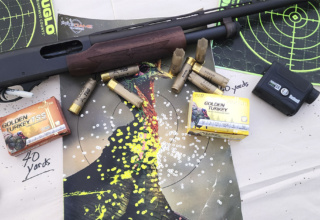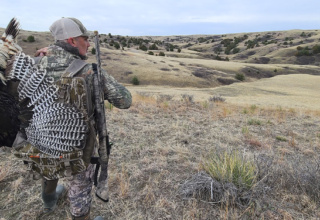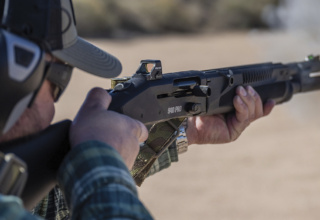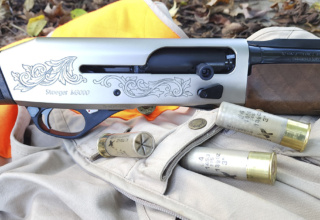Reliable to a fault, an indiscriminate consumer of ammo, and easy on the shoulder, the new Remington Pro Series V3 shotguns hit all the right notes…and birds.
by Larry Case
So, you think it’s easy being a gun writer? All you must do is shoot a bunch of guns and write about them?
Yeah, right.
Let me tell you something, friends and neighbors…it ain’t that easy. I see gun writers get hammered all the time because folks think the writer (A) has no experience with guns and doesn’t know what he or she is talking about, (B) gets a lot of free stuff from gun companies and will never say anything bad about any gun, or, (C) has no experience with guns and doesn’t know what he or she is talking about. I have always been conscious of these concerns since starting down the gun writer trail.
One of the issues you may not have thought about is what if the person doing the gun review genuinely does like the firearm they are looking at? No matter what you do, there will be some in the peanut gallery that will accuse you of fawning to a gun company; it just comes with the territory of being a gun writer. Now, having ranted about that, I will say I like the Remington V3 shotgun and I have since I first shot one at a Remington product event where it was unveiled several years ago.
A Short History Lesson
Remington had its sights set high, in my opinion, to top the Model 1100, as it was the darling of many shooters and hunters for several years—a natural pointer and reliably soft shooter. Remington brought out the VersaMax shotgun (which I quickly named “The Beast” since it shot everything you put in it and tamed recoil)—an autoloader that would shoot any shell from the lightest 2 ¾ loads to the baddest nuclear 3 ½ you could find. The VersaMax did it while possibly being the softest shooter around, all because of a revolutionary gas operating system called VersaPort.
Gas-powered shotguns did not change in the forty years or so after the Model 1100 came out. In 2010, Remington brought a new operation system to the shotgun world. In essence, the company revamped a model for a gas-powered shotgun that was first created in Italy and put to use in the Benelli M4. Remington engineers worked their magic on this concept and gave us the VersaPort system.

What Makes the V3 Tick?
The VersaPort system was revolutionary in a couple different ways. First, it used the length of the individual shell being fired to regulate how much of the expelled gases to be used. With a 2 ¾ shell, all seven of the small ports in the chamber are exposed and these ports put the expelled gas into two compartments that hold the VersaPort pistons and work the action of the shotgun. When a 3-inch round is used, four of the ports are utilized, and when a 3 ½-inch shell is fired, only three ports are uncovered.
Another major breakthrough of the VersaPort system is the concept of how quickly the gas from the fired shell is captured and used. Firearms engineers have long known the faster the gases are captured and used to work the action of the shotgun, or ported out of the system, the less recoil will be transferred to the shooter.
“The impulse (I = Force x time) created by the ignition of a given shell is the same in any shotgun,” said Andy Haskins, a Research and Development Engineer at Remington Arms company. “The VersaPort system utilizes the pressure from a fired shell sooner than other gas systems by venting it through the orifice holes in the chamber. This enables the V3 and Versa Max to convert the energy created by the gas into work to drive the system sooner and over a longer period. By venting the gas earlier, combined with the Supercell recoil pad, we are able to spread out the energy created by the recoil event (impulse) over a longer period of time, therefore reducing the peak force felt by the shooter.” Bottom line, the VersaPort takes a lot of recoil off the shooter.
Conventional gas operated systems before VersaPort located the gas ports as much as ten inches in front of the chamber; the VersaPort utilizes the gases almost immediately. The twin pistons below the chamber, using the force of the expelled gas, move very little, but the bolt is moved backward, the fired casing is ejected, and a new round is chambered. The twin piston system eliminated the use of different O rings, metal adjustment rings, and other items that are sometimes a headache to deal with.
Remington downsized the VersaMax into a three-inch gun, made the receiver much sleeker, kept the good stuff in the VersaPort system and gave us the V3.
It Has to Go BOOM, BOOM, BOOM
The prettiest camo and lots of gizmos on a gun mean nothing if a semi-automatic shotgun will not cycle every time under the worst conditions. The V3 platform and its daddy, the Versa Max, has proven itself in the past in this area, but I burned a lot of powder in the V3 Turkey Pro, Waterfowl Pro, and the Field Sport Walnut anyway. I mixed Aquila, Federal, Remington, and Browning target loads to simply shoot the shotgun, four times quickly, reload, and repeat. I shot some of these rounds at clay targets and some on paper. The shotgun cycled every brand of ammunition and ejected empties a surprising distance. To mix it up, I would sometimes load a heavy turkey load among a string of field or target shells just to see if everything functioned. As a side note, I would say that a 3-inch magnum turkey load going off after a light field load will certainly wake you up in the morning.
I saw the Waterfowl Pro model in action in duck blinds in Arkansas and they seemed to stand up to all the swamp mud and Labrador drool we could dish out. In the pheasant fields of South Dakota, the V3 got a lot of action with the gang I was with, and often the barrels were hot. I don’t remember one malfunction occurring. The bottom line here may be that I shot a lot of rounds in different versions of the V3. I saw several other shooters do the same thing on two different excursions with the shotgun—pheasant and duck hunting. The general consensus was that the V3 is a soft shooter, even with some of the loads we shot.

The Remington Hypersonic Steel loads we shot on the Arkansas are screamers at 1700 feet per second and are certainly not light loads. The same goes for the Remington Nitro Pheasant that we used for pheasants. An ounce and a quarter of #5s going 1400 fps is not a light load (I liked the way the #5s put down pheasants), but I didn’t hear the chatter about recoil I thought I would. Like I said, the VersaPort system soaks up a lot of felt recoil.
The V3 Pro Series Has a Lot of Goodies
All of Remington’s new Pro Series V3 shotguns feature an oversized bolt or charging handle and an oversized bolt release. These can be a big advantage when handling the gun in reloading situations, when gloves and too much adrenaline can get in the way. I like them. The safety is also slightly oversized, and the loading port has been enlarged with some relief cuts for easier loading and fewer pinched fingers.
The V3 Pro Series Waterfowl model has two options with a Burnt Bronze Cerakote barrel and receiver with Realtree Max 5® or Mossy Oak® Shadow Grass Blades™ Camo. Another option features a Patriot Brown Cerakote barrel and receiver with Realtree Timber® Camo. All have 28-inch barrels. All the Pro Series guns are threaded for RemChoke chokes, so the list of possible aftermarket choices is vast.
The V3 Turkey Pro is built on the V3 platform, has a 22-inch barrel, a TRUGLO Headbanger choke, and comes out of the box mounted with a TRUGLO Red Dot optic bore-sighted at 40 yards. The entire gun is dressed in some very sexy Realtree Timber camo. All the Pro Series guns have Supercell recoil pads. A big plus on this shotgun is the 1 ¼-inch that Remington shaved off the length of pull. If you don’t think this is important, take a standard shotgun with a 14-inch length of pull and sit down at the base of a tree as you would when turkey hunting. Shoulder this gun and then mount one with a shorter stock like the V3 Turkey Pro. It makes a difference, and a big one. A shorter stock when sitting is definite advantage as you are less likely to be “crawling up the stock” trying to get a bead on a gobbler.
The basic Field Sport models of the V3 in synthetic black will start with an MSRP of $895.00, the Field Sport models dressed in various camos are a hundred bucks more, and the V3 Pro Series models come in at $1,195.00. As we all know, if you shop around, you are going to find them for somewhat less.
OK, so I like the V3. You will just have to hold that against me. Go shoot one for yourself and you may have to agree with one of those gun writers who has no experience with guns and doesn’t know what they are talking about.





















